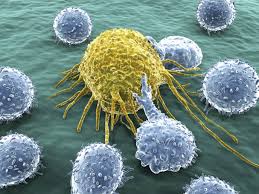There are several types of cancers, which doctors typically define based on what tissue they start in and what part of the body the cancer primarily affects. Breast cancer is the most common type of cancer, followed by lung and prostate cancers.
Sex and gender exist on spectrums. This article will use the terms “male,” “female,” or both to refer to sex assigned at birth. Click here to learn more.
Though cancer can start in any area of the body, the prevalence rate of different cancers varies. Certain cancers occur much more frequently than others.
In some cases, a person’s sex or race can increase the likelihood that they will develop certain types of cancer in their lifetime.
Controllable factors, such as smoking, can also affect a person’s risk for developing certain cancers.
This article reviews the most common types of cancer overall as well as the most common cancers based on sex and race.
To discover more evidence-based information and resources for cancer, visit our dedicated hub.
What is the most common type of cancer?
1265315825
According to the National Cancer Institute (NCI)Trusted Source, in order for a cancer to qualify as a common type, the incidence rate in 2021 had to be at least 40,000.
Based on the NCI’s estimates, the most common cancer type in 2021 was breast cancer, with an estimated 284,200 new cases expected.
The next most common types include both prostate and lung cancers.
Most common types of cancer
The following table provides a ranking of some of the most common cancer types. It also provides numbers for the most recent estimates of new cases and the 5-year relative survival rate.
A relative survival rate helps give an idea of how long a person with a particular condition may live after receiving a diagnosis compared with those without the condition.
For example, if the 5-year relative survival rate is 70%, it means that a person with the condition is 70% as likely as someone without the condition to live for 5 years.
It is important to remember that these figures are estimates. A person can consult a healthcare professional about how their condition is going to affect them.
Rank Cancer Definition Prevalence Percentage of all cancers 5-year relative survival rate
2 prostate cancer starts in the cells of the prostate gland, which is a walnut-size gland, found only in males, that helps produce part of the 248,530 Trusted Source new cases estimated in 2021 13.1%Trusted Source 97.5%Trusted Source
3 lung cancer occurs when cells in the lungs grow out of control 235,760Trusted Source new cases estimated in 2021 12.4%Trusted Source 21.7%Trusted Source
9 endometrial a type of uterine cancer that develops in the lining of the uterus 66,570Trusted Source new cases estimated in 2021 3.5%Trusted Source 81.1%Trusted Source
10 leukemia, all types cancers that affect the blood and often start in the bone marrow 61,090Trusted Source new cases estimated in 2021 3.2%Trusted Source 65%Trusted Source
11 pancreatic starts in the cells of pancreas, which helps regulate how the body uses sugars 60,430Trusted Source new cases estimated in 2021 3.2%Trusted Source 10.8%Trusted Source
12 thyroid starts in the thyroid gland, which helps to regulate several aspects of the body’s functions, including weight gain and temperature regulation 44,280Trusted Source new cases estimated in 2021 2.3%Trusted Source 98.3%Trusted Source
Most common types of cancer for males
Certain cancers affect people assigned male at birth more than others.
Most common types of cancer based on race
The following tables list the top 10 cancers that affect people based on their race, according to the Centers for Disease Control and Prevention (CDC):
White
The table below lists the top 10 cancers to affect white people.
Cancer Prevalence (per 100,000 people)
Breast 127.5
Prostate 98.7
Lung and bronchus 54.5
Colorectal 35.8
Corpus and uterus 27.3
Melanoma 25.1
Urinary bladder 19.6
Non-Hodgkin lymphoma 19.8
Kidney and renal pelvis 17.1
Leukemia 13.7
Black
The table below lists the top 10 cancers to affect Black people.
Cancer Prevalence (per 100,000 people)
Prostate 164.4
Breast 121.2
Lung and bronchus 54.1
Colorectal 40.4
Corpus and uterus 27.9
Kidney and renal pelvis 17.6
Pancreas 16.1
Non-Hodgkin lymphoma 13.5
Myeloma 13.2
Urinary bladder 10.7
American Indian and Alaska Native
The table below lists the top 10 cancers to affect American Indian and Alaskan Native people.
Cancer Prevalence (per 100,000 people)
Breast 65.2
Prostate 47
Lung and bronchus 37.1
Colorectal 25.7
Corpus and uterus 18
Kidney and renal 16.8
Non-hodgkin lymphoma 9.9
Liver and intrahepatic bile duct 9.9
Thyroid 8
Pancreas 7.9
Asian and Pacific Islander
The table below lists the top 10 cancers to affect Asian and Pacific Islander people.
Cancer Prevalence (per 100,000)
Breast 101
Prostate 55.5
Lung and bronchus 32.5
Colorectal 27.8
Corpus and uterus 21.6
Thyroid 14.6
Non-Hodgkin lymphoma 12.6
Liver and intrahepatic bile duct 10.9
Pancreas 9.6
Ovary 8.7
Hispanic
The table below lists the top 10 cancers to affect Hispanic people.
Cancer Prevalence (per 100,000)
Breast 95.5
Prostate 80.2
Colorectal 32.3
Lung and bronchus 27.4
Corpus and uterus 24.8
Kidney and renal pelvis 16.8
Non-Hodgkin lymphoma 16.7
Liver and intrahepatic bile duct 13.3
Thyroid 13.1
Pancreas 11.6
Health disparities
Though every person has a risk of developing cancer, a person’s race can play a role in the prevalence and overall risk of death from cancer.
Reasons for this include racial disparities in healthcare and socioeconomic disparities. For example, 1 in 3Trusted Source Black women state that they have experienced racial discrimination during a visit to a doctor. This can lead to a mistrust in healthcare professionals.
The authors of the 2017 study also noted that people with Hispanic heritage often have similar socioeconomic and cultural trends but lower overall cancer rates.
This led them to look more closely at the role of genes and biological factors as risk factors for cancer as well. They noted that some of the factors that increase a Black person’s chances of chronic inflammation and obesity may also increase their chances of developing cancer.
